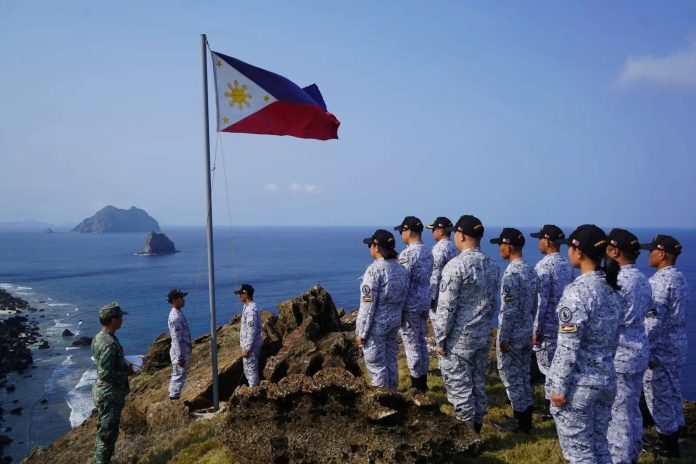The Philippines said its national security adviser and his American counterpart discussed China’s “coercive, aggressive and deceptive actions” amid heightening tensions between the two nations in the South China Sea.
The Philippine National Security Council said in a statement that Philippine National Security Adviser Eduardo Ano “expressed his appreciation for the United States’ continued assurances and reaffirmation of its ironclad commitment” to their alliance, Reuters reported.
Earlier, raising the stakes in the South China Sea, Philipines President Ferdinand Marcos Jr. announced that Manila would take countermeasures against “illegal, coercive, aggressive, and dangerous attacks” by China’s coastguard.
The Philippines is incensed by what it regards as Chinese warships’ ongoing hostilities within Manila’s 200-mile exclusive economic zone.
“We seek no conflict with any nation, more so nations that purport and claim to be our friends, but we will not be cowed into silence, submission, or subservience,” Marcos said on Facebook.
Although Marcos did not provide specifics, he stated that the countermeasures would be proportionate, planned, and reasonable in response to what he described as open and unabating attacks and would be implemented in the coming weeks.
As Manila puts up a strong front against a powerful adversary, it has received moral support from its ally, the United States, as well as its friend, India.
The warning from the Filipino President comes days after a Chinese navy helicopter harassed Filipino researchers surveying sandbars off the Philippine-occupied Pag-asa (Thitu) Island, in yet another incident of intimidation of the Filipinos.
While the researchers were conducting a survey at Cays 3 and 4, two of the four sandbars off Pag-asa, the People’s Liberation Army Navy helicopter, tail number 57, hovered above at a close distance of 20 meters, Jay Tarriela, Philippines Coast Guard (PCG) spokesperson for the West Philippine Sea Commodore told the Inquirer.
Tarriela pointed out that the helicopter’s downwash was a “dangerous” attempt to eject the researchers from the mission. The chopper reportedly flew at a low altitude for about five minutes, splashing sand and corals. Japanese journalists who had been invited witnessed the incident.
The Filipino researchers were part of a collaborative marine research expedition together with the PCG, the University of the Philippines Institute of Biology, the Bureau of Fisheries and Aquatic Resources (BFAR), and the Department of Agriculture-National Fisheries Research and Development
The assignment given to the study team was to evaluate the biodiversity of the underwater reefs on the four sandbars. Last year, there was an alarm when masses of dead coral that seemed to have been purposefully deposited in one of the sandbars was noticed.
During the recent incident, Chinese coast guard and militia boats followed the rubber boats used by the BFAR ships Datu Sanday (MMOV-3002) and Datu Pagbuaya (MMOV-3003) to carry the researchers to the sandbars.
Numerous radio challenges occurred between the two sides, and at one point, the Chinese coast guard even let out a menacing horn-blow sound to intimidate the Filipinos. Despite this targeted harassment, the researchers finished their task and gathered the samples they needed for the investigation.
Tarriela said since the maritime scientific study conducted by the Philippines off the coast of Pag-asa was undertaken in the island’s territorial sea, it was lawful and well within the rights of the PCG.
Filipino fishermen in Pag-asa or Thitu have frequently claimed that every time they go out to fish, Chinese ships push them away from these sandbars. Thitu Island is one of the most prominent and strategically located in the South China Sea. Locally referred to as Pag-asa, Thitu is located roughly 300 miles or 480 kilometers west of the province of Palawan in the Philippines.
Thitu is located just 22 kilometers away from China’s artificial island, ‘Subi. ‘ Subi is one of seven partly submerged reefs that China began converting into a missile-protected group of island bases approximately ten years ago.
On its part, the Philippines is making concerted efforts to clutch onto Thitu Island. Late last year, it inaugurated a new Coast Guard surveillance facility on the island, which has been held by Filipino soldiers since the 1970s. National Security Adviser Eduardo Ano and other Philippine officials flew to Thitu Island to preside over opening the newly constructed, two-story center.
The center will be equipped with radar, ship-tracking, and other monitoring tools to monitor China’s actions in the highly contested waters and other issues, such as maritime accidents. “It’s no longer a gray zone. It’s pure bullying,” Ano told reporters at the time. However, none of these Filipino moves have dissuaded the Chinese from intruding into what the Philippines calls its territorial waters.
The Chinese choppers harassed the researchers on the same day as the China Coast Guard (CCG) ships assaulted a Philippine supply boat with water cannons near Ayungin (Second Thomas) Shoal. This recent round of Chinese aggression has triggered the harshest response from Manila to date.
Philippines, China Trade Barbs
On March 23, a civilian Philippine vessel sustained “heavy damage” from the water cannon deployed by a CCG ship, as seen in footage published by the Armed Forces of the Philippines (AFP).
Additionally, the AFP charged that the Chinese coast guard had engaged in a “dangerous maneuver” by turning the resupply vessel around and then firing the water cannon. It added that China also erected floating barriers to “prevent further entry of any vessels.”
The Philippines alleged that two Chinese “maritime militia” vessels and a Chinese coast guard ship had “impeded and encircled” a Philippine Coast Guard vessel, blocking it off from the resupply boat.
Philippine Coast Guard spokesperson Jay Tarriela said in a post on X that the ship was “isolated from the resupply boat due to the irresponsible and provocative behavior of the Chinese maritime forces, who have shown a disregard for the Convention on the International Regulations for Preventing Collisions at Sea.”
In response to the Chinese coast guard’s water cannon attack, the Philippines launched its “strongest protest” against Beijing on March 25 and called a senior Chinese envoy, according to sources.
The Department of Foreign Affairs released a statement stating that Philippine Foreign Undersecretary Theresa Lazaro expressed “strong protest against the aggressive actions undertaken by the China Coast Guard and Chinese maritime militia against the rotation and resupply mission undertaken by the Philippines” during a phone conversation with her Chinese counterpart.
However, China has been unrelenting. According to a statement from the Chinese side, Chinese Vice Foreign Minister Chen Xiaodong informed Lazaro that the Philippines must exercise caution in choosing its course because ties between the two nations are at a crossroads. He charged that the Philippines was trying to achieve long-term possession of the reef by inciting disturbances at Second Thomas Shoal.
Speaking on behalf of the Chinese Defense Ministry, Wu Qian said on March 28 that the Philippines was responsible for the collapse and that it was invading China’s sovereignty and spreading false information while relying on outside assistance.
“It is straying further down a dangerous path. The Chinese side will not allow the Philippines to act willfully,” Wu told a briefing.
“We have responded with legitimate, resolute, and restrained actions. The Philippine side should realize that provocations will only do themselves more harm than good, and soliciting foreign support will lead nowhere.”









































